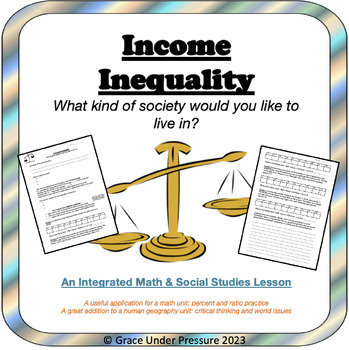Income Inequality & Wealth Distribution Critical Thinking, Math & Social Justice
- PDF
- Easel Activity
Also included in
- Do you need some new, engaging, and applicable math activities for your 6th Grade math unit on Ratios and Proportional Relationships? Here are 6 ready-to-print math products that will get your students thinking about how the math they learn in class (ratios, equivalent ratios, ratio tables, percentaPrice $9.50Original Price $14.00Save $4.50
- Do you need some new, fun, and engaging lessons for your sixth grade math class? If you want to add a little spice to your grade 6 math program, this is the full-year supplemental resource for you!This 140-page MEGA BUNDLE is chock full of real-life applications, financial literacy lessons, math staPrice $52.00Original Price $79.25Save $27.25
- Help your middle school students in grades 6-9 develop critical thinking skills to thoughtfully assess sources of information (media literacy), persuasive arguments, and policy decisions. These are key skills that they will use for the rest of their lives! Fostering critical thinking helps set a solPrice $6.00Original Price $8.00Save $2.00
- This unique bundle of lessons introduces students in grades 7-10 to several current social justice issues related to income inequality and social programs. It supports middle and high school students as they think about what kind of society they want to live in.1) Income Inequality: Using a simple rPrice $11.50Original Price $16.00Save $4.50
Description
What is income inequality? Are the rich getting richer and the poor getting poorer? Is wealth being distributed equally in your country?
This integrated math, social justice, critical thinking, and economics lesson is designed to introduce the idea of income inequality to students in grades 6-9 at a level they can easily understand- all while having them practice important math skills involving ratios and percentages.
This lesson is a useful application for a math unit: percent and ratio practice.
It is also a great addition to a human geography unit: critical thinking and world issues.
What kind of society would you like to live in?
This lesson includes skeleton notes students can take as you teach them about the basics of income inequality:
· Definition
· Causes
· A simple ratio (Palma ratio) used to compare countries
· Solutions
Then students complete a comparison of four different societies that have varying degrees of income inequality. They use simple percent and ratio calculations (at the grade 6-7 level) to complete this work.
Finally, they get to write a paragraph explaining which of the societies they would prefer to live in and why. This is where they can apply their critical thinking and reasoning skills.
What's Included:
5 Page PDF Ready to Print and Go!
- Title Page and Teacher Instructions
- 2 Page Student Worksheet with notes, calculations, and a reflection
- 2 Page Answer Key with prompts to help students start thinking about the reflection










